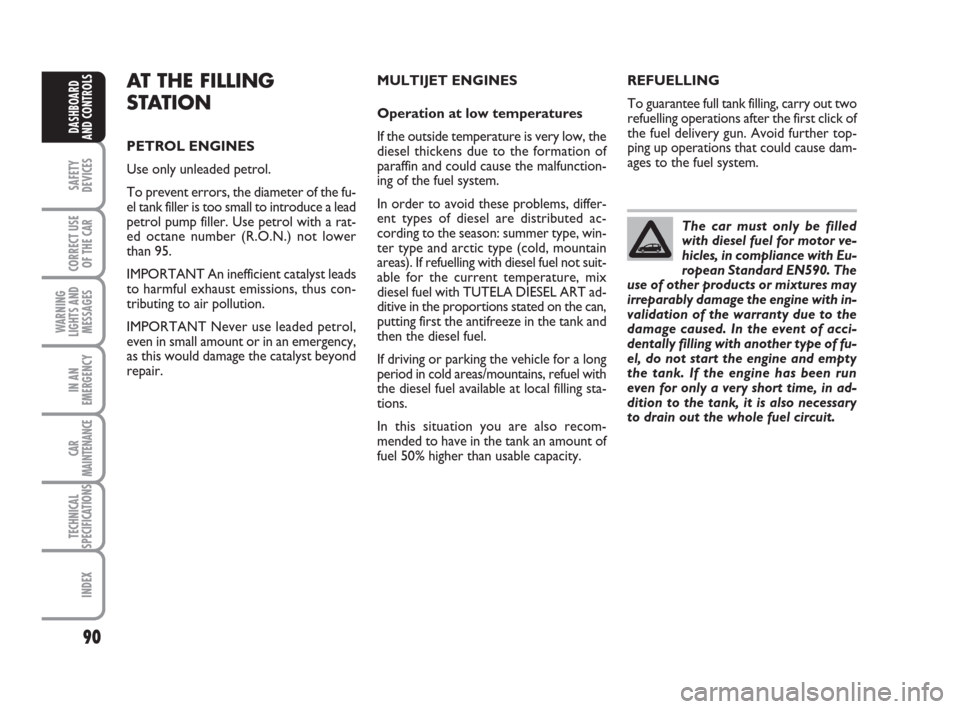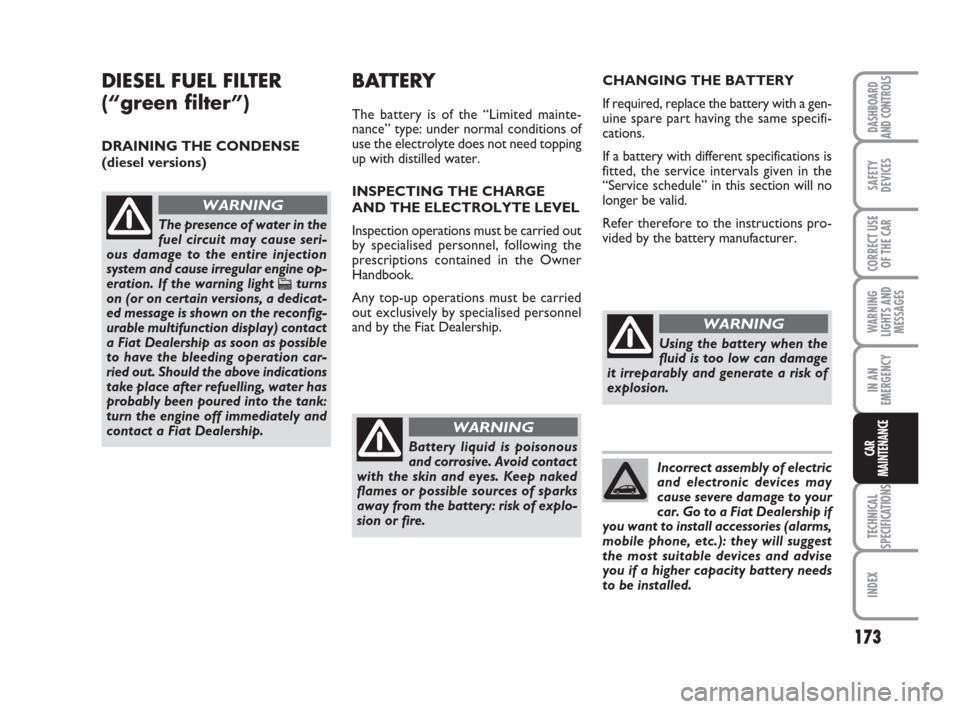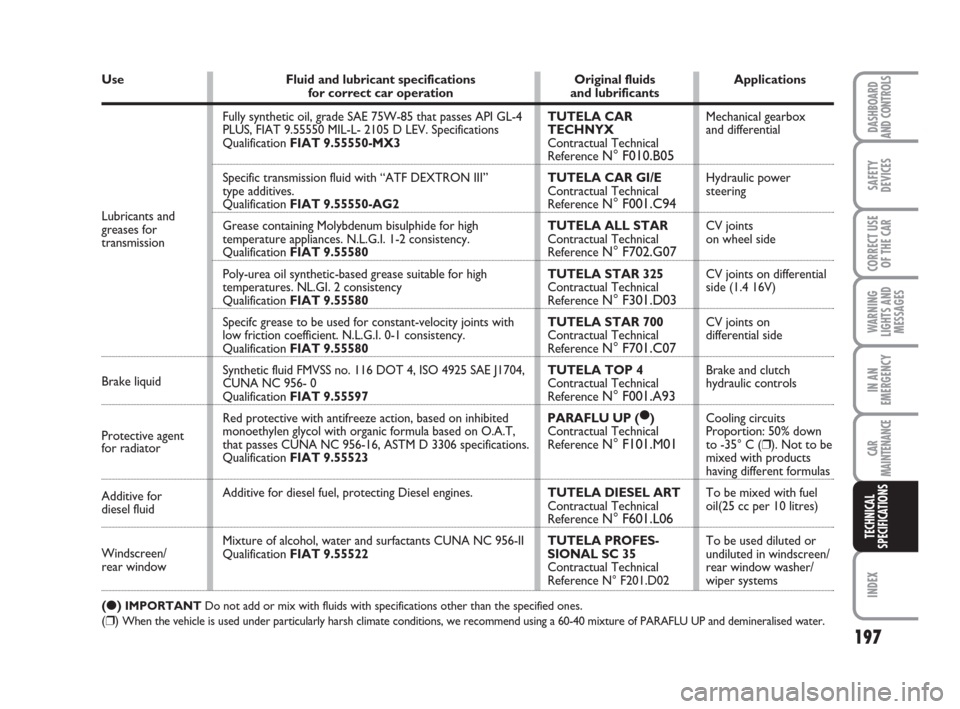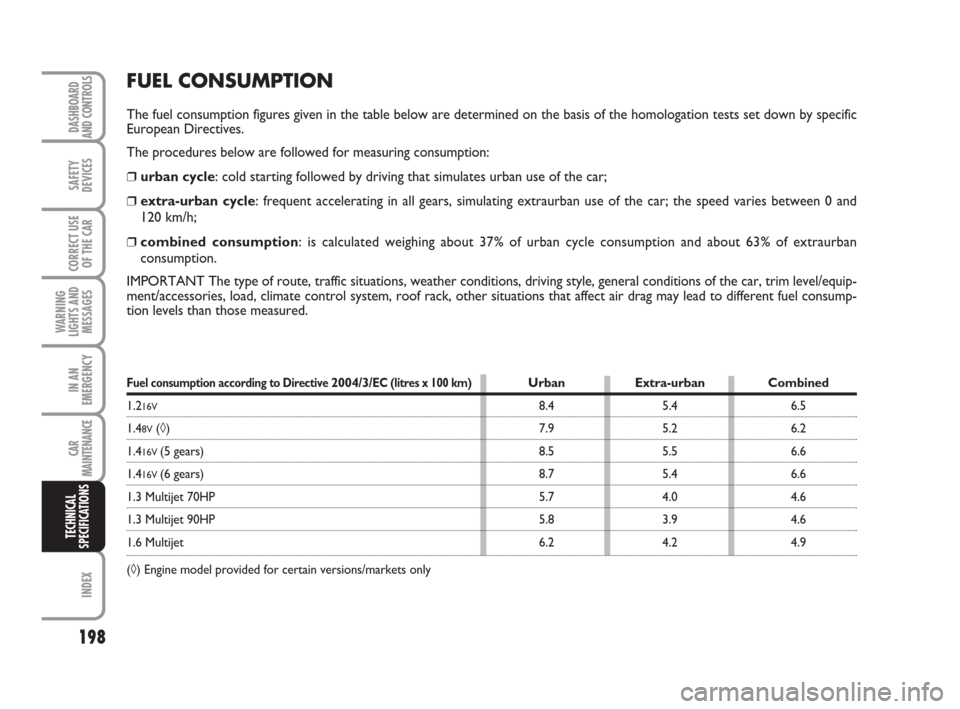fuel type FIAT IDEA 2008 1.G Owners Manual
[x] Cancel search | Manufacturer: FIAT, Model Year: 2008, Model line: IDEA, Model: FIAT IDEA 2008 1.GPages: 210, PDF Size: 3.64 MB
Page 17 of 210

16
SAFETY
DEVICES
CORRECT USE
OF THE CAR
WARNING
LIGHTS AND
MESSAGES
IN AN
EMERGENCY
CAR
MAINTENANCE
TECHNICAL
SPECIFICATIONS
INDEX
DASHBOARD
AND CONTROLSType ofkey
Pressing the pushbutton Ëenables fuel lid to be opened.
The main functions that can be activated with the keys (with or without remote control) are the following:
Door opening
Key turning counterclockwise
(driver’s side)
Key turning counterclockwise
(driver’s side)
Pressing briefly button
Ë
Two flashings
Turning off Door locking
from the outside
Key turning clockwise
(driver’s side)
Key turning clockwise
(driver’s side)
Pressing briefly button
Á
One flashing
Turned on fixed for approx.
3 seconds, followed by deterrence
led flashingBoot
opening
Pressing on button
R
Two flashings
Deterrence led flashing Spare key without
remote control
Main key with
remote control
Direction indicators
flashing (only with key with
remote control)
Deterrence led
001-035 idea GB 1 ed 10-07-2008 8:27 Pagina 16
Page 91 of 210

90
SAFETY
DEVICES
CORRECT USE
OF THE CAR
WARNING
LIGHTS AND
MESSAGES
IN AN
EMERGENCY
CAR
MAINTENANCE
TECHNICAL
SPECIFICATIONS
INDEX
DASHBOARD
AND CONTROLS
The car must only be filled
with diesel fuel for motor ve-
hicles, in compliance with Eu-
ropean Standard EN590. The
use of other products or mixtures may
irreparably damage the engine with in-
validation of the warranty due to the
damage caused. In the event of acci-
dentally filling with another type of fu-
el, do not start the engine and empty
the tank. If the engine has been run
even for only a very short time, in ad-
dition to the tank, it is also necessary
to drain out the whole fuel circuit.
AT THE FILLING
STATION
PETROL ENGINES
Use only unleaded petrol.
To prevent errors, the diameter of the fu-
el tank filler is too small to introduce a lead
petrol pump filler. Use petrol with a rat-
ed octane number (R.O.N.) not lower
than 95.
IMPORTANT An inefficient catalyst leads
to harmful exhaust emissions, thus con-
tributing to air pollution.
IMPORTANT Never use leaded petrol,
even in small amount or in an emergency,
as this would damage the catalyst beyond
repair.MULTIJET ENGINES
Operation at low temperatures
If the outside temperature is very low, the
diesel thickens due to the formation of
paraffin and could cause the malfunction-
ing of the fuel system.
In order to avoid these problems, differ-
ent types of diesel are distributed ac-
cording to the season: summer type, win-
ter type and arctic type (cold, mountain
areas). If refuelling with diesel fuel not suit-
able for the current temperature, mix
diesel fuel with TUTELA DIESEL ART ad-
ditive in the proportions stated on the can,
putting first the antifreeze in the tank and
then the diesel fuel.
If driving or parking the vehicle for a long
period in cold areas/mountains, refuel with
the diesel fuel available at local filling sta-
tions.
In this situation you are also recom-
mended to have in the tank an amount of
fuel 50% higher than usable capacity.REFUELLING
To guarantee full tank filling, carry out two
refuelling operations after the first click of
the fuel delivery gun. Avoid further top-
ping up operations that could cause dam-
ages to the fuel system.
036-092 idea GB 1 ed 10-07-2008 16:12 Pagina 90
Page 93 of 210

PROTECTING
THE ENVIRONMENT
The devices for curtailing petrol engine
emissions are the following:
❒three-way catalytic converter;
❒Lambda sensor;
❒fuel evaporation system.
In addition, do not let the engine run, even
for a test, with one or more spark plugs
disconnected.
The devices for curtailing diesel fuel en-
gine emissions are the following:
❒oxidising catalytic converter;
❒exhaust gas recirculation system
(E.G.R.).
❒diesel particulate filter (DPF)DIESEL PARTICULATE
FILTER (DPF) (for 1.3 Multijet
versions 90 HP)
The Diesel Particulate Filter is a mechan-
ical filter, integral with the exhaust system,
that physically traps particulates present
in the exhaust gases of Diesel engines.
The diesel particular filter has been adopt-
ed to eliminate almost totally particulates
in compliance with current / future law
regulations.
During normal use of the vehicle, the en-
gine control unit records a set of data (e.g.:
travel time, type of route, temperatures,
etc.) and it will then calculate how much
particulates has been trapped by the filter.
Since this filter physically traps particulates,
it shall be cleaned (reclaimed) at regular
intervals by burning carbon particles.
Reclaiming procedure is controlled auto-
matically by the engine control unit ac-
cording to the filter conditions and the
conditions of use of the vehicle.
During normal service the
catalyst reaches high tem-
peratures. Do not therefore park the
car over inflammable materials (grass,
dry leaves, pine needles, etc.): fire
hazard.
WARNING
During reclaiming the following phenom-
ena could take place: idling slight increase,
fan activation, slight smoke increase, high
exhaust temperatures. These situations
shall not be considered as faults and they
do not affect vehicle performance and en-
vironment.
If the dedicated message is displayed, re-
fer to paragraph “Warning lights and mes-
sages”.
DASHBOARD
AND CONTROLS
INDEX
TECHNICAL
SPECIFICATIONS
CAR
MAINTENANCE
IN AN
EMERGENCY
WARNING
LIGHTS AND
MESSAGES
CORRECT USE
OF THE CAR
SAFETY
DEVICES
92
036-092 idea GB 1 ed 10-07-2008 16:12 Pagina 92
Page 174 of 210

173
TECHNICAL
SPECIFICATIONS
INDEX
DASHBOARD
AND CONTROLS
SAFETY
DEVICES
CORRECT USE
OF THE CAR
WARNING
LIGHTS AND
MESSAGES
IN AN
EMERGENCY
CAR
MAINTENANCE
DIESEL FUEL FILTER
(“green filter”)
DRAINING THE CONDENSE
(diesel versions)
The presence of water in the
fuel circuit may cause seri-
ous damage to the entire injection
system and cause irregular engine op-
eration. If the warning light
cturns
on (or on certain versions, a dedicat-
ed message is shown on the reconfig-
urable multifunction display) contact
a Fiat Dealership as soon as possible
to have the bleeding operation car-
ried out. Should the above indications
take place after refuelling, water has
probably been poured into the tank:
turn the engine off immediately and
contact a Fiat Dealership.
WARNING
BATTERY
The battery is of the “Limited mainte-
nance” type: under normal conditions of
use the electrolyte does not need topping
up with distilled water.
INSPECTING THE CHARGE
AND THE ELECTROLYTE LEVEL
Inspection operations must be carried out
by specialised personnel, following the
prescriptions contained in the Owner
Handbook.
Any top-up operations must be carried
out exclusively by specialised personnel
and by the Fiat Dealership.
Battery liquid is poisonous
and corrosive. Avoid contact
with the skin and eyes. Keep naked
flames or possible sources of sparks
away from the battery: risk of explo-
sion or fire.
WARNING
CHANGING THE BATTERY
If required, replace the battery with a gen-
uine spare part having the same specifi-
cations.
If a battery with different specifications is
fitted, the service intervals given in the
“Service schedule” in this section will no
longer be valid.
Refer therefore to the instructions pro-
vided by the battery manufacturer.
Using the battery when the
fluid is too low can damage
it irreparably and generate a risk of
explosion.
WARNING
Incorrect assembly of electric
and electronic devices may
cause severe damage to your
car. Go to a Fiat Dealership if
you want to install accessories (alarms,
mobile phone, etc.): they will suggest
the most suitable devices and advise
you if a higher capacity battery needs
to be installed.
161-180 idea GB 1 ed 10-07-2008 8:30 Pagina 173
Page 198 of 210

197
INDEX
DASHBOARD
AND CONTROLS
SAFETY
DEVICES
CORRECT USE
OF THE CAR
WARNING
LIGHTS AND
MESSAGES
IN AN
EMERGENCY
CAR
MAINTENANCE
TECHNICAL
SPECIFICATIONS
Windscreen/
rear window Protective agent
for radiator Brake liquid Lubricants and
greases for
transmission
Use
(●) IMPORTANT Do not add or mix with fluids with specifications other than the specified ones.
(❒) When the vehicle is used under particularly harsh climate conditions, we recommend using a 60-40 mixture of PARAFLU UP and demineralised water.
Fluid and lubricant specifications
for correct car operation
Fully synthetic oil, grade SAE 75W-85 that passes API GL-4
PLUS, FIAT 9.55550 MIL-L- 2105 D LEV. Specifications
Qualification FIAT 9.55550-MX3
Specific transmission fluid with “ATF DEXTRON III”
type additives.
Qualification FIAT 9.55550-AG2
Grease containing Molybdenum bisulphide for high
temperature appliances. N.L.G.I. 1-2 consistency.
Qualification FIAT 9.55580
Poly-urea oil synthetic-based grease suitable for high
temperatures. NL.GI. 2 consistency
Qualification FIAT 9.55580
Specifc grease to be used for constant-velocity joints with
low friction coefficient. N.L.G.I. 0-1 consistency.
Qualification FIAT 9.55580
Synthetic fluid FMVSS no. 116 DOT 4, ISO 4925 SAE J1704,
CUNA NC 956- 0
Qualification FIAT 9.55597
Red protective with antifreeze action, based on inhibited
monoethylen glycol with organic formula based on O.A.T,
that passes CUNA NC 956-16, ASTM D 3306 specifications.
Qualification FIAT 9.55523
Additive for diesel fuel, protecting Diesel engines.
Mixture of alcohol, water and surfactants CUNA NC 956-II
Qualification FIAT 9.55522Original fluids
and lubrificants
TUTELA CAR
TECHNYX
Contractual Technical
Reference
N° F010.B05
TUTELA CAR GI/E
Contractual Technical
Reference
N° F001.C94
TUTELA ALL STAR
Contractual Technical
Reference
N° F702.G07
TUTELA STAR 325
Contractual Technical
Reference
N° F301.D03
TUTELA STAR 700
Contractual Technical
Reference
N° F701.C07
TUTELA TOP 4
Contractual Technical
Reference
N° F001.A93
PARAFLU UP (●)
Contractual Technical
Reference
N° F101.M01
TUTELA DIESEL ART
Contractual Technical
Reference
N° F601.L06
TUTELA PROFES-
SIONAL SC 35
Contractual Technical
Reference N° F201.D02 Additive for
diesel fluidApplications
Mechanical gearbox
and differential
Hydraulic power
steering
CV joints
on wheel side
CV joints on differential
side (1.4 16V)
CV joints on
differential side
Brake and clutch
hydraulic controls
Cooling circuits
Proportion: 50% down
to -35° C (❒). Not to be
mixed with products
having different formulas
To be mixed with fuel
oil(25 cc per 10 litres)
To be used diluted or
undiluted in windscreen/
rear window washer/
wiper systems
181-199 idea GB 1 ed 13-10-2008 12:12 Pagina 197
Page 199 of 210

198
INDEX
DASHBOARD
AND CONTROLS
SAFETY
DEVICES
CORRECT USE
OF THE CAR
WARNING
LIGHTS AND
MESSAGES
IN AN
EMERGENCY
CAR
MAINTENANCE
TECHNICAL
SPECIFICATIONS
FUEL CONSUMPTION
The fuel consumption figures given in the table below are determined on the basis of the homologation tests set down by specific
European Directives.
The procedures below are followed for measuring consumption:
❒urban cycle: cold starting followed by driving that simulates urban use of the car;
❒extra-urban cycle: frequent accelerating in all gears, simulating extraurban use of the car; the speed varies between 0 and
120 km/h;
❒combined consumption: is calculated weighing about 37% of urban cycle consumption and about 63% of extraurban
consumption.
IMPORTANT The type of route, traffic situations, weather conditions, driving style, general conditions of the car, trim level/equip-
ment/accessories, load, climate control system, roof rack, other situations that affect air drag may lead to different fuel consump-
tion levels than those measured.
Fuel consumption according to Directive 2004/3/EC (litres x 100 km)Urban Extra-urban Combined
1.216V8.4 5.4 6.5
1.48V(◊) 7.9 5.2 6.2
1.416V (5 gears) 8.5 5.5 6.6
1.416V (6 gears) 8.7 5.4 6.6
1.3 Multijet 70HP 5.7 4.0 4.6
1.3 Multijet 90HP 5.8 3.9 4.6
1.6 Multijet 6.2 4.2 4.9
(◊) Engine model provided for certain versions/markets only
181-199 idea GB 1 ed 13-10-2008 12:12 Pagina 198